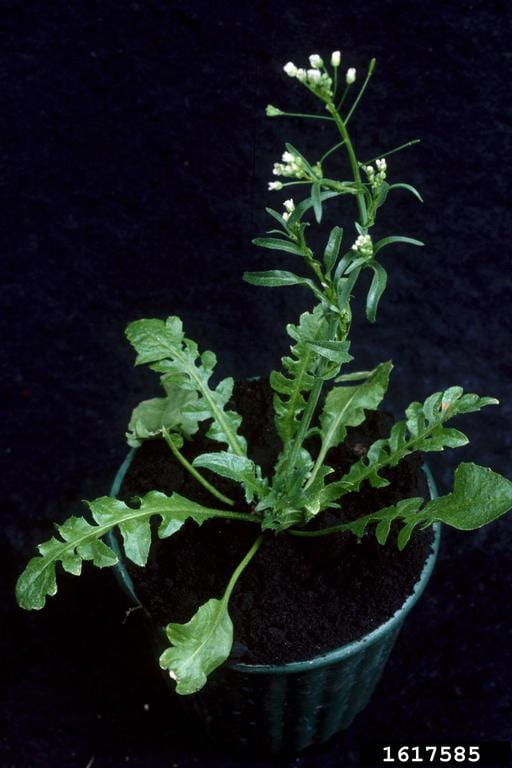Shepherd’s purse (Capsella bursa-pastoris) is a weedy mustard that is normally a winter or summer annual in New York, germinating in the fall and overwintering or germinating in the spring. It is a common weed of winter crops, disturbed soils, hay fields, and waste areas. This species is named for its distinctive, triangular seedpods. It is also the only weedy mustard in New York with star-shaped hairs, which makes it relatively easy to identify even before seeds develop.
Shepherd’s purse is one of 3000+ species in the mustard family. For help identifying weedy mustards either in the rosette or flowering phase, please visit our mustard identification page.
Identification
Seedlings: Cotyledons are egg-shaped to rounded with a light green to purple seedling stem (hypocotyl). The first two to four leaves are rounded with untoothed or slightly toothed margins. The first two leaves are opposite, with both unbranched and star-shaped hairs. Subsequent leaves are alternately arranged in a basal rosette. Rosette leaves range from entire to toothed to deeply lobed, mostly deeply lobed, with a line of hairs on the lower leaf along the main vein and upper leaves that are smooth to lightly haired with star-shaped hairs.
Leaves: Mature leaves are alternate and may be smooth or hairy and toothed or lobed. Basal rosette leaves are oblong and taper to the base.
Mature plant: Stems of the mature plant are slender and green to purple, with gray star-shaped hairs near the base and smoother towards the top, and leaves only on the lower part of the stem. The flowering stem can grow up to .7m (~30″) tall, and sometimes branch towards the top. Stem leaves are alternate and lance-shaped without lobing or petioles (leaf-stems). Flowers emerge in the spring, and flowering is continuous until early summer; if a plant over-summers or emerges in the fall, there can be a round of flowers in the slate fall. The root system has a thin, branched taproot with fibrous secondary roots.
Multiple mature shepherd’s purse plants
Photo by Lynn Sosnoskie of University of Georgia, Bugwood.org
Flowers/Fruit: Each shepherd’s purse flower is relatively small and produced in a cluster that elongates to a long spike, with seedpods forming towards the bottom while new flowers are produced at the top. The flower has 4 white petals (2-4 mm (1/10”-1/5”) long) and 4 green sepals. Shepherd’s purse fruit have a characteristic flattened, triangular to heart-shaped pod reminiscent of an ancient Greek shepherd’s bag, hence the plant name. The fruit is 4-8 mm (3/10”) long and about as wide.
Management
Chemical control
New York specific guidance can be found in the Cornell Crop and Pest Management Guides, or click below for chemical control options for shepherd’s purse from Cornell’s turfgrass and weed weed identification app.
While no herbicide resistant shepherd’s-purse has found in New York, this species has developed Group 2 (AlS inhibitors like imazapyr) resistance in five countries including Canada, and Group 5 (photosystem II inhibitors like simazine and metribuzin) resistance in Europe and in Oregon.
Non-chemical control
Shepherd’s purse seedlings are very small, and control at that life stage is very effective. Tine-weeding and mechanical cultivation can work well in this stage. Rotating with warm season crops and planting competitive crops in high density can also help, as well as field cleanup after shoulder season short crops such as lettuce. Fall harrowing can work well on fall-germinating shepherd’s purse. Dense planting and organic mulches are also very effective, given how small the plant is in early life stages. Animal grazing provides fair control of the weed.
References
Uva R H, Neal J C, DiTomaso J M. 1997. Weeds of the Northeast. Book published by Cornell University, Ithaca NY. The go-to for weed ID in the Northeast; look for a new edition sometime in 2019.
Cornell University’s Turfgrass and Landscape Weed ID app. Identification and control options for weeds common to turf, agriculture, and gardens in New York; uses a very simple decision tree to identify your weed.
Most organic management suggestions are from Dr. Charles Mohler of Cornell University. Look for an upcoming book from Dr. Mohler on ecological management of weeds, from Cornell University Press.
Treatment Options page from Weed Control in Natural Areas in the Western United States from University of California, Davis. Provides simplified descriptions of non-chemical and chemical weed management options.
The International Herbicide-Resistant Weed Database, found at weedscience.org, provides documentation of global herbicide resistance.









